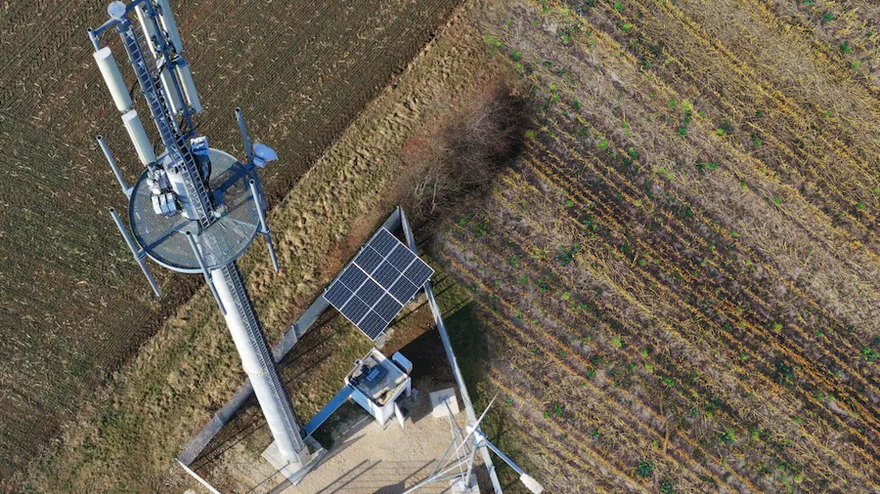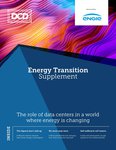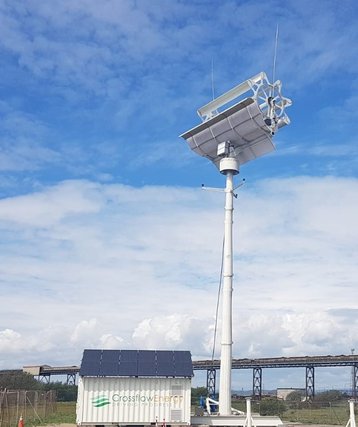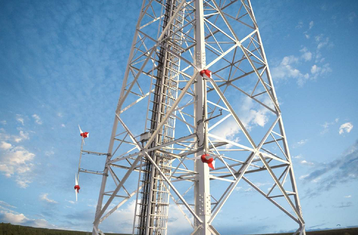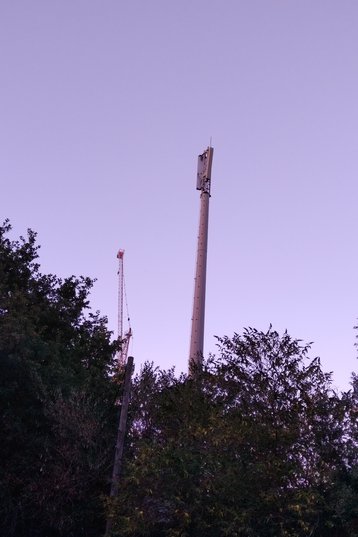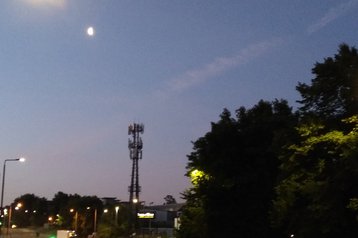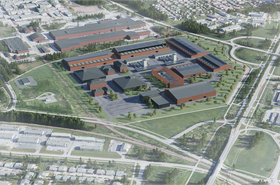Compared to data centers, the energy requirements of individual cell towers are a pittance. A typical 4kW cell site pales in comparison to the 20-50kW rack densities we are now seeing.
But with more than 400,000 cell tower sites in the US alone, they outnumber data centers and their power footprint totals a not-insubstantial 21 million megawatt hours (MWh) of power per year.
As energy prices soar, ESG continues to grow in importance, and 5G’s increased power demands loom, a number of cell tower owners and telco operators are looking at deploying wind and solar power generation systems at the cell sites themselves.
Are we close to self-sufficient cell sites at scale, or even a potential transition to off-grid cell towers en masse?
Wind turbines at cell sites
The start of this year saw Vodafone-owned Vantage Towers announce plans to install 750 wind turbines on 52 of its cell towers in Germany. The project will create a generation capacity of up to 650 MWh per year.
The installation of the micro wind turbines is scheduled by the end of the year, provided that all necessary permits have been issued by then.
“By generating renewable power directly on site, we create a cost-efficient and maintenance-friendly way to cut down energy costs for our customers while at the same time accelerating Europe’s sustainable digitalization,” says Enrico Schadock, senior business development manager at Vantage Towers, who is managing the Mowea rollout.
Schadock explains either 4, 8, or 16 turbines will be installed at each tower depending on the power requirements of the tower in question combined with wind quantity & speed. Each pair of turbine units has a nominal capacity of 1kW in winds of 3.5m/s or more; the units have an approximate energy output of 1,500kWh per year.
Vantage operates around 83,000 macro sites in Europe, so 52 sites is still a small trial. But assuming the pilot project goes well, the companies aim to expand to more locations in Germany and Vantage Towers’ other markets in Europe.
Testing on-site cell tower power
While operators in emerging markets where the grid is less developed or reliable have long deployed solar and wind at cell sites, it is only in recent years that companies are starting to look at similar deployments in more developed markets such as Europe.
And unlike in developing markets, high land prices and little space combined with resilient energy grids can make it hard to justify the cost. Add in the fact many northern European markets don’t get much sun for large portions of the year, and further challenges arise.
But Vantage’s trial is one of a number of small-scale pilots and projects around deploying on-site renewable power at cell towers in Europe and elsewhere. While the results seem promising in isolation, none of the companies are deploying such solutions at scale yet.
Also in Germany, Deutsche Telekom is partnering with Ericsson to test self-sufficient cell towers. The German telco and Swedish OEM have conducted a trial at a live cell tower site in Germany where it was able to operate entirely from wind and solar energy generated by on-site panels and turbines.
The site – in the Bavarian municipality of Dittenheim, about 120km north of Munich – has been part-powered by energy from 12 sqm of solar modules installed more than a year ago. The two companies have since added a wind turbine, capable of providing up to five kilowatts of additional power, as a second renewable energy power source.
Initial tests showed that on windy days, more renewable energy could be generated than was consumed by site operations.
In the UK, Vodafone has been working with Crossflow Energy for two years to use the latter’s wind turbine technology in combination with solar and battery technologies to create a self-powered mobile network tower.
Founded in 2008, Crossflow Energy has developed a unique transverse axis wind turbine designed to generate power from ‘small wind;’ locally generated wind power for single locations. Created in collaboration with Swansea University, the turbine incorporates a patented shield which delivers optimum lift and drag performance across a wide range of wind speeds, keeping low rotational speed and minimal vibration.
The companies said the Eco-Towers will enable the deployment of new mobile sites in remote locations, without the usual difficulty and cost of connecting to the electricity grid. The new sites will be owned and managed by Cornerstone Telecommunications Infrastructure Limited and not part of Vodafone's own tower network.
In Australia, Telstra has installed an off-grid solar and battery storage solution at one of its cell towers in Mount Ney, east of Esperance, Western Australia, The company partnered with local energy firm Horizon Power and its subsidiary Boundary Power to transition a remote mobile tower from an overhead power supply to a standalone power system (SPS).
The SPS unit is powered by eight kilowatt (kW) solar panels, a 16.8kW hour battery and a 26kW back-up generator, which together can deliver 12kW of continuous power. The companies said at least six more mobile tower SPS will be deployed throughout Horizon Power’s service area over the coming 24 months.
Richard Webb, director of network infrastructure, CCS Insight, tells DCD he estimates that less than 10 percent of cell towers have at least some of their power generated directly at the cell site by renewable energy, possibly as low as the ‘low single digits. But he notes the interest and demand is there as part of these companies’ wider sustainability drives.
“Energy is a big part of operators' operational expenditure,” he says. “So they all want to reduce their energy bills; reduce costs, you're improving profits.”
“I do think there is a challenge to change [the status quo], because if you've got power and it works, and you're happy with it, it's a cost to you as an operator to decide to change that. So it is a big operational and capex-based decision.”
Telcos face an OPEX challenge as energy price rises
While many major telcos are signing power purchase agreements (PPAs) to procure renewable energy at the grid level, reducing energy network costs is always a priority for operators looking to reduce their OPEX. At a time when energy prices are soaring, more on-site energy generation at cell sites is growing in urgency.
“The interest in sustainable energy solutions within the industry has definitely increased over the past years; mobile network operators (MNOs) have been trying to reduce their overall energy consumption for years,” says Vantage’s Schadock. “By generating sustainable energy directly on site, we have found a cost-effective way to meet this demand and the current surge in energy prices further accelerates this development.”
Latvian telco LMT has had a small trial of solar-powered base stations running for several years. The company found that during the summer months, cell tower sites may cover their energy requirements for a total of around one month, but generated almost no power during the winter months. As things currently stand, LMT doesn’t have the option to go fully solar-powered.
However, Aigars Benders, LMT’s technical director, tells DCD that in the wake of rising energy costs this year, the company has explored the feasibility of deploying solar panels at all of its 1,500 sites.
It found the ROI for sub-3kW sites was still effectively zero, and so still hard to justify from a cost perspective. But some sites with loads around 6KW start to create a positive return on investment after 8-15 years. If the prices continue to rise, more sites start to show a positive ROI.
“Five years ago, the reason for this experiment was to discover opportunities to be more environmentally friendly. Now, with rising energy expenses, it has an entirely different meaning from a business perspective and even risk management,” he says. “The bigger the site, the better the business case, that’s the conclusion [now].”
Vantage told us that it isn’t planning donating energy it generates at cell-sites back to the grid; if more energy is generated than is consumed, the turbines will be throttled by the turbine’s control systems. However, Latvia’s LMT is considering a different tack.
The telco hopes to create solar farms to power the equivalent multiple base stations. The company has large land plots at around 10 sites where bigger solar projects could be deployed.
“By building one big solar farm we can feed many sites. Upcoming changes in the legislation will say that if, for instance, we build up a solar site with 100 kilowatts of power – there are no such base station sites – we can feed the electricity back to the electrical network,” says LMT’s Benders.
“Most probably the kilowatts generated at cell sites will be exchanged for money. So when we generate an excess amount of power and feed it back to the grid, for that price we can the next day, next few days, we can power other sites.”
Futureproofing towers for 5G's energy demands
The turn-off of legacy 3G networks and more energy-efficient RAN hardware might help reduce some of the power requirements of cell tower sites, but the future is still likely to be a more power-hungry network.
5G hardware is currently a small part of the overall traffic managed by operators, but as roll-out continues, it will soon become the main source of the mobile landscape’s energy requirements. Not only will the hardware potentially require more energy, but there will be more sites, compounding the energy demand.
“The energy efficiency of 5G is significantly higher than that of previous mobile phone generations (e.g. UMTS or LTE), so the
energy requirement per megabyte is significantly lower with 5G, but the overall consumption at the site increases due to the much higher possible bandwidths,” says Vantage’s Schadock. “This is another reason why Vantage Towers is working on solutions to develop a 100 percent self-sufficient power supply with a combination of wind, solar, hydrogen, and LNG.”
A typical 3-sector base station site holding hardware from several carriers could draw anywhere between 2.5 to 10kW, but would typically sit somewhere in the middle. MTN Consulting estimates operators spend around 5-6 percent of their operating expenses, excluding depreciation and amortization, on energy costs.
But the analyst firm says a typical 5G base station consumes up to twice or more the power of a 4G base station; it notes that the industry consensus is that 5G will double to triple energy consumption for mobile operators, once networks scale. Likewise, ABI Research predicts energy consumption is expected to increase 160 percent between 2020 to 2030 due to the energy demands of network elements like massive MIMO, the proliferation of 5G cell sites, and the flexibility of the 5G networks in both consumer and enterprise use cases.
In the future, ABI predicts a typical 3.5GHz site deploying massive MIMO with four transmitters and four receivers – also supporting 2G, 3G, and 4G – might draw 14kW on average and up to 19kW under peak load.
In 2019, China Mobile EVP Li Zhengmao said that its electricity costs were rising fast – with 5G sites seeing a fivefold increase in traffic compared to LTE – and said Chinese telcos need preferential electricity pricing or subsidies to aid 5G network deployment.
Huawei data from FierceWireless suggest the typical 5G site has power needs of over 11.5kW, up nearly 70 percent from a base station deploying a mix of 2G, 3G, and 4G radios.
While energy-efficiency is constantly improving as OEMs introduce new hardware iterations, one benefit of 5G is the application of greater intelligence to network management; hardware can be powered down during off-peak hours, meaning sites will require less energy during quieter periods of the day. How much smarter network management will offset greater data demands is still unclear at this point.
“Yesterday was the time to act if they're not already,” warns CSS’s Webb. “Any operators that aren't being very, very serious about getting their energy bills down, using all the tools that are available, they're sitting on a time bomb.”
The paradox of on-site renewables
However, the practical roll-out of 5G poses a problem. Power-hungry 5G hardware will initially be deployed in metro areas where space is at a premium and power networks are most reliable.
This makes it harder to find sites where it is practical to deploy turbines or solar panels, and harder still to make the costs work. The added challenge that sites are more likely to be leased also adds to the complications.
Conversely, more rural cell sites might well have space available at a reasonable cost, but lower data traffic means lower power requirements and therefore makes the cost of deployment harder to justify.
But as solar panels become more efficient and more able to generate larger amounts of power in smaller footprints, the ROI inevitably becomes easier to justify. The same applies to battery storage.
“The whole industry needs to be more focused now on those alternative energy sources. The complete solution is solar, wind, battery backups, plus grid as well,” says LMT’s Benders. “The industry really needs to look at different aspects and come together and discuss now what else can be done.”
CCS Insight’s Webb, adds: “It will proliferate, I have absolutely no doubt about that. How far and to what extent, I don't know.
“Technology is improving. As renewables improve in terms of performance and efficiency, more cell sites can incorporate that. And of course, as you go up in volume, that equipment should come down in price.”
He warns of a “chicken and egg standoff,” where volume orders will get put in when the prices come down but prices will only come down when volume orders are put in.
“Someone's got to move first and it's good to see Vodafone and others doing that. As more operators do it the technology should come down in price and therefore be an easier pill to swallow in terms of investment.”

